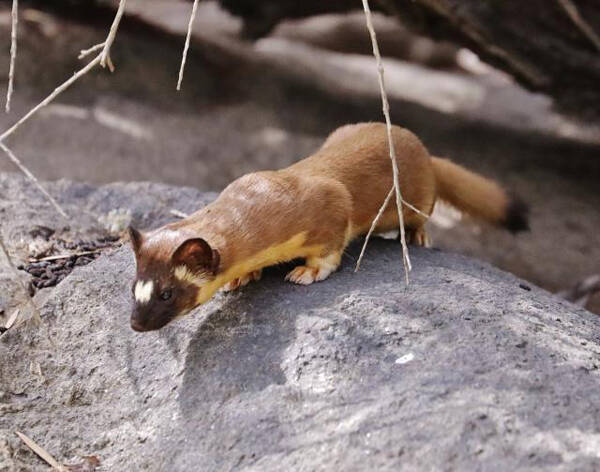Mustela frenata
IUCN
LCBasic Information
Scientific classification
- name:Mustela frenata
- Scientific Name:Mustela frenata,Long-tailed Weasel、Bridled Weasel、Big Stoat,White-browed weasel, greater weasel
- Outline:Carnivora
- Family:mustelae genus
Vital signs
- length:20-26xm
- Weight:80-450g
- lifetime:About 3 years
Feature
The face is black with regular white patches, and the ears are large, upright, and slightly triangular.
Distribution and Habitat
Origin: Belize, Bolivia (Plurinational State), Brazil, Canada, Colombia, Costa Rica, Ecuador, El Salvador, Guatemala, Honduras, Mexico, Nicaragua, Panama, Peru, United States, Venezuela (Bolivarian Republic of).
It lives in mountain forests, river valleys, grasslands, low hills, farmlands, and shrubs near villages.
Appearance
The long-tailed weasel is 203-266 mm long and weighs 80-450 g, with an average of 150.6 g; the total length of the tail accounts for 40%-70% of the body length, with long black hair at the end. The eyes are large and bright, and the ear shells are large and upright, slightly triangular. The long-tailed weasel living in Florida and the southwestern United States has white or yellowish markings on the face. The fur on the back of the body is brown in the summer, and the lower body is white; from the chin to the groin area is yellow, tan or brown. The tail has a distinct black tip. The long-tailed weasel living in Florida and the southwestern United States has white or yellowish markings on the face. The long-tailed weasel living in the northern region has a white fur in winter, sometimes with a yellow hue, but the tail retains the black tip. Females are 10-15% smaller than males.
The long-tailed weasel sheds its fur twice a year, once in the fall (mid-October-November) and once in the
Details
Long-tailed Weasel (scientific name: Mustela frenata) is also known as Long-tailed Weasel, Bridled Weasel, Big Stoat, and has a total of 42 subspecies.

Long-tailed weasels mostly live alone except during mating season; they have sharp vision and hearing, and are quick to move. Once disturbed, they disappear into the woods in an instant. They can forage for food both during the day and at night, but mostly at night. When food is scarce, they also come out to hunt during the day, and their activity range is within 5-10 square kilometers. They mostly catch prey on the ground, and are also very flexible in climbing trees. When food is scarce in winter, they migrate to low mountain areas and return when the weather warms up. There are two main gaits when moving on the ground: trotting and running and jumping. They always run and stop, sniff and look, and sometimes look around with their heads raised. When hunting and avoiding enemies, they run and jump at the same time. Generally, they can jump up to 30 cm. Some people also think that they can jump up to 2 meters. Its footprints are a deep pit in the deep snow, and clear claw marks can be seen on the ice surface with a light snow cover.
The long-tailed weasel is a carnivore with a diet similar to that of minks. Its prey is mainly small rodents, with mice and voles being the first choice, but it also eats shrews, squirrels, chipmunks and snow hares. Especially when small mammals are scarce, they will also prey on insects, earthworms, frogs, snakes, birds and bird eggs. The hunting method is typical of weasels, and about 20%-30% of the time is spent eating every 24 hours.
The long-tailed weasel searches for food all year round, both during the day and at night. It walks on the ground or in the snow, lives in burrows, and may hunt at a distance of 11 kilometers from its burrow. It can swim and climb trees when chasing prey, sometimes reaching great heights.
The long-tailed weasel chooses its den on the ground, under tree stumps or in piles of rocks. It usually does not dig its own burrows, but uses abandoned burrows of chipmunks. The burrow is 22-30 cm in diameter, and the chamber is 60 cm from the entrance of the burrow, and is lined with straw and prey fur. The mating period is between July and August. The gestation period of the long-tailed weasel is about 10 months, and the fertilized eggs have a dormant period and can only implant and develop in about March of the following year. Generally, 5-8 pups are produced per litter. The young are usually born in April or May, when small mammals are abundant in the spring. Newborns are naked, hairless, blind, and weigh 3 grams, about the same weight as hummingbirds. But they grow rapidly, and at three weeks old, they will grow fur and can grab meat outside the nest, weighing 21-27 grams. At 5 weeks old, the young can open their eyes, engage in physical activities and make chirping sounds. At this stage, they begin to be weaned, and after a week, they will appear near the nest and accompany their mother to hunt. They grow up completely in autumn, and the family disbands at this time. The growth and maturity period of females is 3-4 months, while males reach sexual maturity at 15-18 months.
Listed in the 2013 Red List of Endangered Species of the World Conservation Union (IUCN) ver 3.1 - Least Concern (LC).
Protect wild animals and stop eating game.
Maintaining ecological balance is everyone's responsibility!








